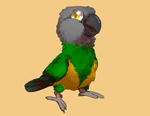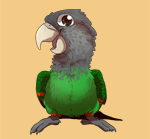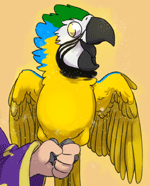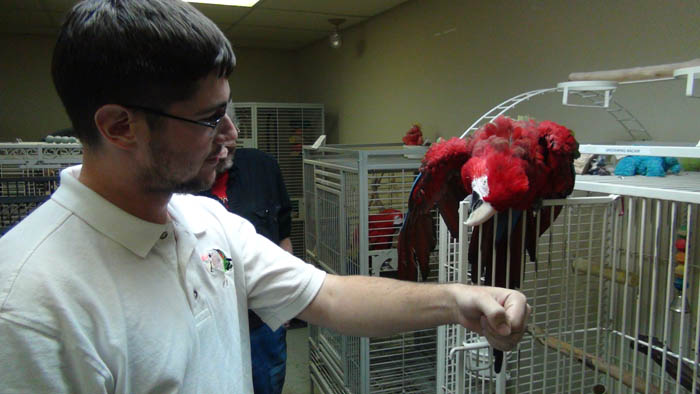 Kili
Type: Senegal Parrot
Genus: Poicephalus
Species: Senegalus
Subspecies: Mesotypus
Sex: Female
Weight: 120 grams
Height: 9 inches
Age: 15 years, 10 months
|
 Truman
Type: Cape Parrot
Genus: Poicephalus
Species:Robustus
Subspecies: Fuscicollis
Sex: Male
Weight: 330 grams
Height: 13 inches
Age: 14 years, 1 month
|
 Rachel
Type: Blue & Gold Macaw
Genus: Ara
Species:ararauna
Sex: Female
Weight: 850 grams
Height: 26 inches
Age: 11 years, 10 months
|
List of Common Parrots:
Parakeets:
Budgerigar (Budgie)
Alexandrine Parakeet
African Ringneck
Indian Ringneck
Monk Parakeet (Quaker Parrot)
Parrotlets:
Mexican Parrotlet
Green Rumped Parrotlet
Blue Winged Parrotlet
Spectacled Parrotlet
Dusky Billed Parrotlet
Pacific Parrotlet
Yellow Faced Parrotlet
Lovebirds:
Peach Faced Lovebird
Masked Lovebird
Fischer's Lovebird
Lilian's (Nyasa) Lovebird
Black Cheeked Lovebird
Madagascar Lovebird
Abyssinian Lovebird
Red Faced Lovebird
Swindern's Lovebird
Lories and Lorikeets:
Rainbow Lorikeet
Conures:
Sun Conure
Jenday Conure
Cherry Headed Conure
Blue Crowned Conure
Mitred Conure
Patagonian Conure
Green Cheeked Conure
Nanday Conure
Caiques:
Black Headed Caique
White Bellied Caique
Poicephalus Parrots:
Senegal Parrot
Meyer's Parrot
Red Bellied Parrot
Brown Headed Parrot
Jardine's Parrot
Cape Parrot
Ruppell's Parrot
Eclectus:
Eclectus Parrot
African Greys:
Congo African Grey (CAG)
Timneh African Grey (TAG)
Amazons:
Blue Fronted Amazon
Yellow Naped Amazon
Yellow Headed Amazon
Orange Winged Amazon
Yellow Crowned Amazon
Cockatoos:
Cockatiel
Galah (Rose Breasted) Cockatoo
Sulphur Crested Cockatoo
Umbrella Cockatoo
Moluccan Cockatoo
Bare Eyed Cockatoo
Goffin's Cockatoo
Macaws:
Red Shouldered (Hahn's) Macaw
Severe Macaw
Blue And Gold Macaw
Blue Throated Macaw
Military Macaw
Red Fronted Macaw
Scarlet Macaw
Green Winged Macaw
Hyacinth Macaw
Glossary of Common Parrot Terms
|
| | Thursday April 17th, 2014 |
|
Negative reinforcement is perhaps the most misunderstood of the methods of operant conditioning. Although negative is used in the term, it does not mean “bad.” Instead, negative means “negating” or taking something away. Reinforcement on the other hand refers to increasing behavior. Again this neither means good or bad but just means that the behavior will recur with greater frequency.
In the game of animal training, increasing desired behavior is generally the goal so reinforcement is to be used. But the question remains as to whether it ought to be positive or negative?
When it comes to whether an animal “wants” to do something, it should make little difference whether the reinforcement be positive or negative. Avoiding something aversive may be as, if not more, desirable as gaining something nice. Pretty much any behavior that relates to safety is going to be based on negative reinforcement. There is nothing bad about being safe and in fact it is a good thing.
So why does negative reinforcement carry a bad rep? Part of it is the misunderstanding of the word negative, where in this context it does not mean doing something bad. Many people confused negative reinforcement with positive punishment. Based on common language it would seem that negative reinforcement should be the opposite of positive but based on psychological terms that is not the case. Let's not get carried away with technical definitions and focus more on the meanings.
The main reason negative reinforcement is perceived badly is because professional trainers (or tamers as they used to be called) would intentionally introduce aversives, pressure, or pain to animals for the sake of being able to stop causing it as a reward for desirable behavior. This is how horses, donkeys, camels, elephants, and many other animals have been trained for thousands of years. Basically it would involve beating the animal a lot and letting it learn that if it would do what it was commanded, then the hurt would stop.
If a trainer walks around with a stick, hook, or whip, its very presence symbolizes negative reinforcement and that if the animal stops doing what it is supposed to, then it will be used. What's bad about this? If the animal always does what it is supposed to, the instrument won't even be used. The problem is that the animal is acting simply out of fear and not out of a genuine desire. This does not lead to a great relationship between animal and trainer. If the trainer were to stop carrying around the negative reinforcement instrument, extinction would begin to occur. Whenever the animal would slip up and not receive the normally expected beating, the animal would realize that it no longer has to do as the trainer commands. This is why this type of negative reinforcement is neither truly effective nor nice.
But just because professionals misuse negative reinforcement, does not mean that it is all bad. The professional does not seek to have a personal relationship with the animal like a pet owner would. The professional needs little more than for the animal to do its tricks on command in front of spectators. On the other hand, the exotic pet parrot owner seeks desirable behavior throughout the day and a fantastic relationship to go with it. Thus clearly a relationship based on fear cannot be the solution.
Negative reinforcement is frequently misused in the parrot community although most are unaware they are even applying it. “Stick training” where a dowel is shoved into a parrot's belly until it steps up is an example of the misuse of negative reinforcement that is neither ideal training nor good for the relationship. The parrot learns to step on a stick before it gets nudged. But what happens when a hand is substituted for the stick? The parrot may opt to bite the hand instead because unlike the stick, it isn't inanimate. The parrot doesn't learn to always step up but instead learns to step when a negative-reinforcement instrument is used.

If you aren't scared of a bite and let your arm be like an inanimate object, the same effect can be achieved and the parrot will even learn that biting is futile. But the arm becomes just as much the negative-reinforcement tool as it a part of your body. This is conveniently tempting because unlike treats, you can have this (your arm) with you all the time. The problem is that if the parrot has any alternative to reluctantly complying (such as flying away, clinging to the drapes, running under the cage, etc), it may choose to do those instead because they are less intimidating/painful than the arm into belly shove. The arm is both the thing you want the parrot to trust/like and the instrument of aversion which creates a dilemma. The parrot learns to step up onto the arm to avoid the arm. Thus this example of the classic step up routine, really is a parallel to the circus days of animal training.
If a parrot's wings are not clipped, it is difficult for the trainer to be able to apply negative reinforcement because the bird will sooner fly away than put up with threats to do a behavior. The old school approach of clipping, flooding, and trainer induced negative reinforcement fail to drive cooperation when a parrot is no longer clipped which makes the owner choose to clip the wings again. Genuine success cannot be achieved this way.
I'm not going to get into the more successful positive reinforcement based method to training, you can find the details of this in my book, The Parrot Wizard's Guide to Well-Behaved Parrots. Instead, I'd like to write a bit about the positive side of negative reinforcement. How can negative reinforcement be a good thing?
Well, negative reinforcement is the increase of behavior through reduction in aversives. Thus any means of providing safety is essentially negative reinforcement. Safety is the reduction of danger and thereby a sought thing. There are naturally present dangers that drive fear in a captive parrot's life. By providing safety from these naturally present aversives, we can both provide comfort to our parrot as well as receive some training benefit out of it.
I do not believe that parrot owners should be intentionally causing harm to their pets in order to get to rescue it. But if the aversive already exists, then why not take some training advantage out of it? In fact, capitalizing on these negative reinforcement opportunities should help strengthen the bond rather than harm it. If the parrot realizes that it can receive protection from its fears through you, that will actually improve your relationship. This works as long as those aversives are not created (or even perceived to be created) by you.
For example if there is a loud disturbance going on outside, by stepping up for you, you bring your parrot to a quieter room, the parrot would be negatively reinforced for stepping up. The scary disturbance would be reduced by action you took to protect the parrot and the parrot would be more likely to step up for you in the future.
Here are some other examples from my experience. I take Kili & Truman to the park regularly to fly on harnesses or free fly. Sometimes the kids become too bothersome and I can tell the bird is getting a bit flustered. I will offer the bird a chance to flight recall to me and stay on me to avoid further confrontation. I don't have to give a treat for this type of flight recall because the bird gets reinforced negatively in the process.
Another recent example was when I took Santina to the vet for the first time. I was still in the early stages of gaining trust with her and using a lot of positive reinforcement to encourage her to step up. After Santina came back from anesthesia, Lorelei put Santina down on the floor. From the other end of the room I put my arm down. I did not go over to get Santina but instead she walked over to come to me. I was not giving out treats or head scratches. Santina came to me for safety and thus negative reinforcement for coming. I would not torment her with a towel (and I'm sure the vet wouldn't either) but since it was medically necessary and going to happen regardless, I might as well take the opportunity to take credit for providing safety. This is a case of a good application of negative reinforcement. The parrot learned to come to me for safety in moments of panic rather than to flee or worse yet that the danger was caused by me in the first place.

One of the reasons negative reinforcement tends to be ineffective is because of desensitization with time. As the animal begins to get used to an aversive or pain, it may loose its effect. Especially if the aversive turns out to be physically harmless, the parrot will realize and stop responding to it. For this reason either a stronger dose of aversive is necessary or the behavior is lead toward extinction. Since I don't mind my parrots to stop fearing the naturally present aversives they encounter, I am not worried if the negative reinforcement will lose effect. If my parrots stop fearing these things, I will be just as happy because I don't want them to be fearful. I only use occasional natural negative reinforcement on behaviors that are already trained through positive reinforcement. Since I do not cause the aversives intentionally myself (and disassociate with any aversives that could be perceived as caused by me), the intensity of the aversive should not change. Further, these types of scenarios are fairly infrequent anyway. But since they happen from time to time, I capitalize on the situation and play the role of savior for my parrot.
Let me illustrate with human example. Let's say you are on a long cross country trip with a friend driving. You get an upset stomach and really have to get to a bathroom. So your friend is very understanding and gets you to one promptly to one in return for asking persuasively. We can agree that you gain nothing from going to the bathroom but you do get relief so this is negative reinforcement. You would then be grateful to your friend for helping you find relief from something uncomfortable that isn't your friend's fault. Now what if your friend put something in your lunch that caused this? Even though your friend saves the day by getting you to a bathroom, they were still the cause of your discomfort. Would you be happy and grateful to them? Probably not. You'd be more angry that they caused you discomfort in the first place. This is the difference between giving negative reinforcement to a natural/unrelated aversive vs being the cause of the aversive. Negative reinforcement can only work well when it is providing relief from something you have not caused or associated with.
So am I encouraging you to go and use negative reinforcement with your parrot? Not necessarily. What I am encouraging you to do is to give further thought into whether or not you are rewarding by giving something (positive reinforcement) or rewarding by taking something away (negative reinforcement)? Are you threatening in some way that until the parrot does something you want, you will do something? Why should your parrot comply with your requests and what will the consequence be if it does not? Being more aware and intentional in your training means will ensure that you are making the most effective application but also help you to ensure a good relationship. Making sure that you are not causing aversives but helping to reduce naturally occurring ones will work in your favor.
My book almost exclusively focuses on training using positive reinforcement because this needs to be the basis of any parrot relationship. However, this article is a supplement for those who already use positive reinforcement. This is for those who want to take their training to an even further level and learn to apply the good kind of negative reinforcement responsibly to get even more out of their training.
Avoid using threats (whether it be with a stick, your arm, a squirt bottle, or going back in the cage) and do things so the parrot would want to engage in the behavior without coercion. But on the other hand, when there are opportunities to save your parrot from uncontrolled environmental factors, take training advantage by having the parrot do something for it. Stepping up, coming to you, flying to you, etc are all important behaviors and ones that the parrot can learn to do more readily when it feels scared. By teaching your parrot to come to you rather than away, you can ensure that in times of panic, your parrot is more likely to return to you and that your relationship can be so good that you would be your parrot's means for safety. Negative reinforcement is often misused but it is not always bad. Focus on the good stuff with your parrot and your relationship will be better than ever. |
|



 Older Articles
Older Articles